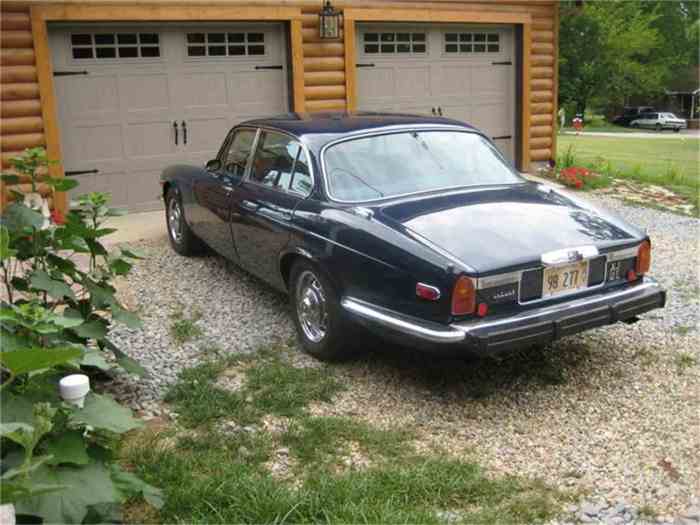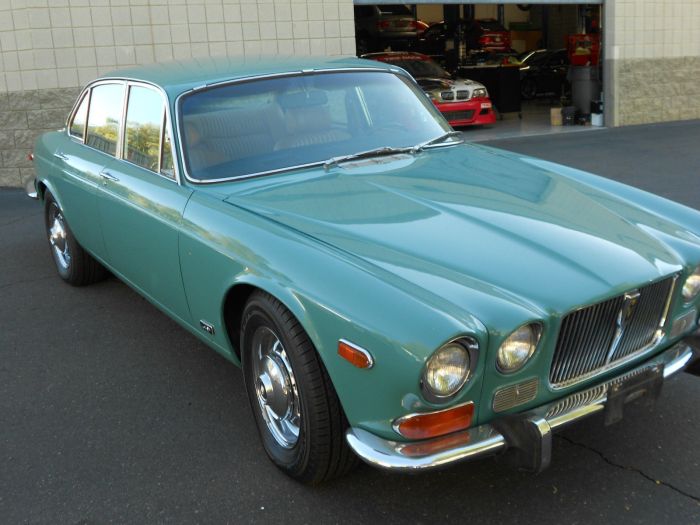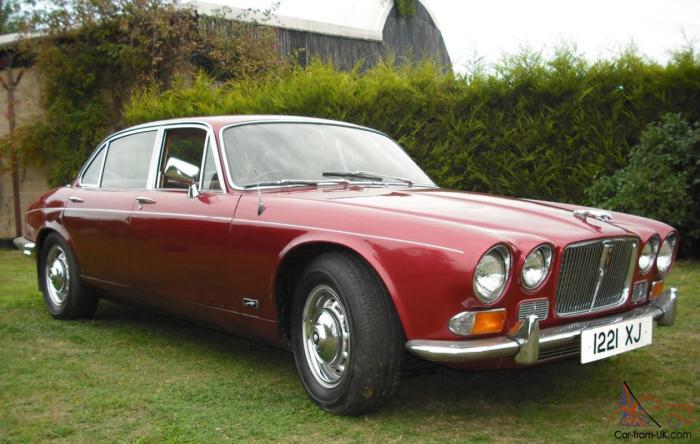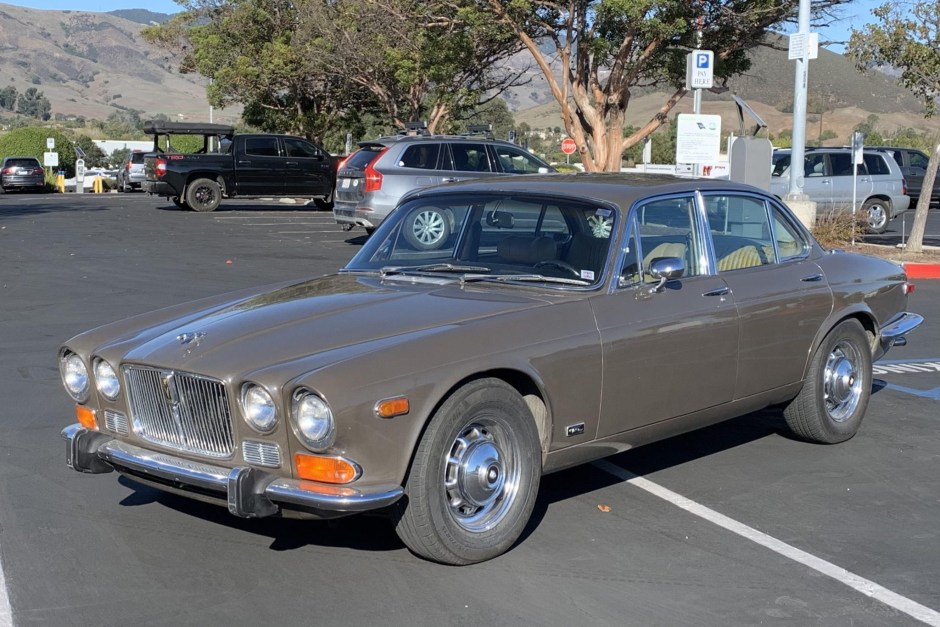1973 Jaguar XJ12, a name synonymous with British automotive excellence, represents a pinnacle of luxury and performance. Launched in 1972, the XJ12 marked a significant moment in Jaguar’s history, introducing a powerful V12 engine to the already iconic XJ series.
This sleek and sophisticated saloon, with its graceful lines and advanced engineering, quickly established itself as a symbol of refined taste and driving prowess, captivating enthusiasts and establishing a legacy that endures today.
The 1973 Jaguar XJ12 wasn’t merely a car; it was a statement. Its design, penned by Sir William Lyons, embodied the essence of British elegance, while its powerful V12 engine offered a level of performance that was both exhilarating and refined.
The XJ12’s arrival coincided with a period of economic growth and social change, and it quickly became the car of choice for those who sought a blend of luxury, performance, and timeless style.
The 1973 Jaguar XJ12: A Luxurious Icon

The 1973 Jaguar XJ12, a luxurious grand tourer, marked a significant moment in automotive history. Launched in 1972, it represented a pinnacle of British engineering and design, solidifying Jaguar’s position as a maker of sophisticated and powerful automobiles. The XJ12 became a symbol of elegance and performance, capturing the spirit of the era.
Design and Features
The XJ12’s design was a testament to the vision of Sir William Lyons, Jaguar’s founder. The car’s sleek, aerodynamic body was characterized by its long hood, fastback roofline, and distinctive grille. The XJ12’s interior was equally impressive, featuring luxurious leather upholstery, wood trim, and a range of advanced features for the time.
Key Features
- Powerful V12 Engine:The XJ12 was powered by a 5.3-liter V12 engine, producing 271 horsepower. This engine provided exceptional performance, with a top speed of 140 mph and a 0-60 mph time of 7.5 seconds.
- Independent Suspension:The XJ12 featured independent suspension on all four wheels, providing a comfortable and controlled ride.
- Power Steering and Disc Brakes:The car was equipped with power steering and disc brakes on all four wheels, enhancing handling and safety.
- Luxurious Interior:The interior of the XJ12 was a testament to British craftsmanship, featuring luxurious leather upholstery, wood trim, and a range of advanced features for the time.
Design and Engineering

The 1973 Jaguar XJ12 represented the culmination of years of design and engineering innovation, building upon the legacy of its predecessors and setting a new standard for luxury and performance. The XJ series, launched in 1968, had already established itself as a stylish and sophisticated car, but the 1973 model took things to a whole new level with its iconic design and powerful V12 engine.
The Evolution of the Jaguar XJ Series
The Jaguar XJ series, launched in 1968, was a radical departure from the previous Jaguar saloons. The XJ was a sleek, modern car with a spacious interior and a luxurious feel. It was designed by Sir William Lyons, the founder of Jaguar, and it was a huge success, winning numerous awards and becoming one of the most sought-after cars in the world.
- The original XJ, known as the Series I, was powered by a 2.8-liter straight-six engine, which was later upgraded to a 3.4-liter unit. The Series I XJ was a technological marvel for its time, featuring a fully independent suspension, disc brakes all around, and a luxurious interior.
- In 1973, the Series II XJ was launched, with a redesigned front end and a new range of engines, including the powerful V12. The Series II XJ also featured a number of improvements to the interior, including a new dashboard and seats.
- The 1973 XJ12, with its powerful V12 engine, was the pinnacle of the XJ series, combining the sleek design of the Series I with the enhanced performance and features of the Series II.
Iconic Design Elements
The 1973 Jaguar XJ12 is renowned for its elegant and timeless design.
- The car’s sleek lines and flowing curves give it a graceful and aerodynamic appearance. The long, low hood, the raked windshield, and the rounded rear end all contribute to the XJ12’s distinctive profile.
- The large, chrome-plated grille, with its prominent Jaguar emblem, is a striking feature that instantly identifies the car.
- The XJ12’s interior is equally impressive, with its luxurious leather upholstery, walnut veneer trim, and a range of advanced features for the time, such as air conditioning and power windows.
Innovative Engineering Features, 1973 Jaguar XJ12
The 1973 Jaguar XJ12 was not only a stylish car but also a technological marvel, featuring a number of innovative engineering features.
The 1973 Jaguar XJ12, with its sleek lines and powerful V12 engine, was a masterpiece of British engineering. Its luxurious interior and sporty handling made it a favorite among discerning drivers. While the XJ12 represented the pinnacle of Jaguar’s luxury sedan offerings at the time, the company continued to innovate, leading to the release of the 1985 Jaguar XJS , a stylish coupe that combined the XJ’s elegance with a more athletic design.
Despite the differences in body style, both cars shared a commitment to performance and refinement, making them enduring icons of Jaguar’s legacy.
- The car’s independent suspension, with coil springs and telescopic shock absorbers, provided a comfortable and responsive ride.
- The XJ12 was equipped with disc brakes all around, which provided superior stopping power compared to drum brakes.
- The most notable engineering feature of the XJ12 was its powerful 5.3-liter V12 engine. This engine was smooth, quiet, and powerful, producing 271 horsepower and 320 lb-ft of torque. The V12 engine was a testament to Jaguar’s engineering prowess and it was a key factor in the XJ12’s success.
Performance and Handling

The 1973 Jaguar XJ12 was renowned not only for its luxurious interior and elegant design but also for its powerful engine and refined handling. This section delves into the technical aspects that contributed to the XJ12’s impressive performance and driving experience.
Engine Specifications and Performance
The heart of the 1973 Jaguar XJ12 was its 5.3-liter (326 cubic inch) V12 engine, a marvel of engineering for its time. This engine produced 271 horsepower at 5,400 rpm and 320 lb-ft of torque at 3,500 rpm. This powerful engine allowed the XJ12 to accelerate from 0 to 60 mph in about 8 seconds and reach a top speed of 130 mph.
- Displacement:5.3 liters (326 cubic inches)
- Configuration:V12
- Power Output:271 horsepower at 5,400 rpm
- Torque:320 lb-ft at 3,500 rpm
- 0-60 mph:Approximately 8 seconds
- Top Speed:130 mph
In comparison to other luxury cars of the era, the 1973 Jaguar XJ12 stood out for its combination of power and refinement. It offered a performance level that was comparable to, or even surpassed, many of its competitors, including the Mercedes-Benz 450SE and the Rolls-Royce Silver Shadow.
Driving Experience and Handling Characteristics
The 1973 Jaguar XJ12 offered a unique driving experience that was characterized by a blend of power, comfort, and precision. The V12 engine provided smooth and effortless acceleration, while the car’s suspension provided a comfortable ride even on rough roads.
The XJ12’s handling was also impressive for its time, with precise steering and good stability at high speeds.
“The XJ12’s handling was precise and predictable, making it a pleasure to drive on winding roads.”
A contemporary review of the 1973 Jaguar XJ12
The XJ12’s power steering system, a feature that was not common in luxury cars at the time, contributed to its precise and responsive handling. This, combined with its independent suspension, allowed the car to navigate corners with confidence and agility.
Interior and Comfort
The interior of the 1973 Jaguar XJ12 was a testament to British luxury car craftsmanship. It was designed to provide a comfortable and opulent driving experience, reflecting the high standards of the era.
Interior Design and Materials
The interior was characterized by its elegant design and use of high-quality materials. The dashboard featured a simple and functional layout with a focus on driver-centric ergonomics. The use of real wood veneers for the dashboard, door panels, and center console added a touch of sophistication and warmth.
Leather upholstery was standard, with options for various colors and textures, further enhancing the luxurious feel. The attention to detail was evident in the quality of the stitching, the precise fit of the components, and the overall aesthetic appeal.
Features Contributing to Comfort
Several features contributed to the XJ12’s comfortable driving experience. The seats were generously sized and offered excellent support, thanks to their well-padded construction and adjustable features. The ample legroom and headroom provided a spacious and relaxing environment for both the driver and passengers.
The suspension system, designed for a smooth ride, effectively absorbed road imperfections, minimizing vibrations and ensuring a comfortable journey. The sound insulation was also noteworthy, effectively blocking out exterior noise and creating a serene cabin environment.
The 1973 Jaguar XJ12, with its powerful V12 engine, was a symbol of luxury and performance. While the XJ12 was a true powerhouse, Jaguar also offered the more affordable XJ6, like the 1988 Jaguar XJ6 , which offered a more refined and comfortable driving experience.
The XJ12, however, remained a highly sought-after model for its unique combination of elegance and power.
Comparison with Other Luxury Cars of the Time
The 1973 Jaguar XJ12’s interior was considered to be among the best in its class, rivaling other luxury cars of the time. While competitors like the Mercedes-Benz S-Class and the Rolls-Royce Silver Shadow offered comparable levels of luxury, the XJ12 stood out for its elegant design, its use of high-quality materials, and its driver-centric focus.
The XJ12’s interior was a perfect blend of comfort, sophistication, and practicality, making it a true icon of British luxury.
Legacy and Influence

The 1973 Jaguar XJ12’s impact on the automotive industry extended beyond its luxurious features and powerful engine. It solidified Jaguar’s position as a leading manufacturer of high-performance luxury cars and influenced the design and engineering of subsequent Jaguar models.
Impact on the Automotive Industry
The XJ12’s introduction in 1972 marked a significant shift in the luxury car market. It offered a unique blend of performance, elegance, and comfort, challenging established players like Rolls-Royce and Bentley. The car’s success demonstrated the potential for a luxurious yet sporty driving experience, setting a trend that would influence future luxury car designs.
The 1973 Jaguar XJ12, with its powerful V12 engine, represented a pinnacle of luxury and performance. While it boasted a classic, timeless design, the model continued to evolve, with the introduction of the 1988 Jaguar XJSC , a sleek coupe variant that further emphasized the car’s sporty character.
The XJ12’s legacy lives on in these later models, showcasing the brand’s commitment to both elegance and driving excitement.
Legacy and Influence on Subsequent Jaguar Models
The XJ12’s design and engineering principles served as a foundation for subsequent Jaguar models. Its sleek, aerodynamic bodywork, spacious interior, and powerful V12 engine became hallmarks of Jaguar’s identity. The XJ12’s influence can be seen in later XJ models, including the XJ40 and XJ8, which carried forward its design cues and performance aspirations.
Anecdotes and Stories from Owners and Enthusiasts
Owners and enthusiasts of the 1973 Jaguar XJ12 often describe the car as a timeless classic. They appreciate its elegant styling, comfortable ride, and powerful engine. Many recall the thrill of driving the car, its smooth acceleration and effortless handling making it a joy to drive.
Stories abound of owners taking their XJ12s on long journeys, enjoying the car’s comfort and reliability.
The 1973 Jaguar XJ12 in Popular Culture
The 1973 Jaguar XJ12, with its sleek design and powerful engine, quickly became a symbol of luxury and sophistication. Its presence in various forms of media, from movies to television shows, solidified its status as a coveted icon, captivating audiences and contributing to its enduring legacy.
Appearances in Movies and Television
The 1973 Jaguar XJ12’s presence in movies and television shows played a significant role in shaping its image and reinforcing its association with wealth, power, and style. Here are some notable examples:
- The Italian Job (1969):This classic heist film features a trio of 1969 Jaguar XJ6s, the predecessor to the XJ12, in a thrilling escape scene. The cars’ agility and performance in the film cemented their association with daring and excitement, further contributing to the Jaguar brand’s image of sophistication and adventure.
- The Persuaders! (1971-1972):This British television series, starring Tony Curtis and Roger Moore, featured a 1971 Jaguar XJ6 as the primary vehicle of the two wealthy private investigators. The car’s sleek design and luxurious interior became synonymous with the show’s stylish and glamorous tone, further enhancing its appeal to viewers.
- Miami Vice (1984-1989):While not specifically the 1973 model, the 1985 Jaguar XJ-S was a frequent sight in the popular television series, driven by the show’s protagonist, Detective Sonny Crockett. The car’s sleek lines and powerful engine perfectly complemented the show’s gritty and stylish atmosphere, further associating the Jaguar brand with the allure of the 1980s Miami scene.
Portrayal in Popular Culture
The 1973 Jaguar XJ12 has been portrayed in popular culture as a symbol of status, wealth, and refinement. Its association with successful individuals and glamorous lifestyles has contributed to its enduring appeal and iconic status.
- Music Videos:The car has appeared in numerous music videos, often associated with artists known for their luxurious lifestyles and sophisticated taste. For example, the 1973 Jaguar XJ12 features prominently in the music video for “Smooth Criminal” by Michael Jackson, reinforcing its connection to high-profile entertainers and the world of music.
- Advertising:The 1973 Jaguar XJ12 has been used in numerous advertising campaigns, showcasing its elegance, power, and luxurious appeal. The car’s association with luxury brands and successful individuals further solidifies its image as a symbol of success and refinement.
- Literature:The 1973 Jaguar XJ12 has also found its way into literature, often used to represent the characters’ wealth and sophistication. For example, in the novel “The Bonfire of the Vanities” by Tom Wolfe, the protagonist, Sherman McCoy, drives a 1973 Jaguar XJ12, reflecting his status as a successful investment banker.
Collecting and Restoration

The 1973 Jaguar XJ12, a symbol of British automotive luxury and performance, has become a sought-after classic car for collectors and enthusiasts worldwide. Its elegant design, powerful engine, and luxurious interior continue to captivate car lovers, making it a rewarding and challenging experience to own and restore.
The Current Collector Market
The collector market for the 1973 Jaguar XJ12 is thriving, with prices steadily increasing over the past few years. The demand for well-preserved and restored examples is high, driven by the car’s enduring appeal and its status as a significant piece of automotive history.
Prices can vary significantly depending on the condition, mileage, and provenance of the car.
Challenges and Rewards of Ownership
Owning and restoring a 1973 Jaguar XJ12 presents both challenges and rewards.
Challenges
- Finding a good example:Locating a well-maintained or unrestored XJ12 can be challenging, as many have been neglected or modified over the years. Finding an original, unmolested example is a treasure hunt.
- Restoration costs:Restoring a 1973 Jaguar XJ12 to its former glory can be an expensive undertaking, as parts can be scarce and labor costs can be high. Sourcing parts for a car this old can be a challenging, time-consuming, and costly process.
- Technical complexity:The XJ12’s complex mechanical systems require specialized knowledge and skills to maintain and repair.
- Availability of specialists:Finding skilled mechanics and restoration specialists who have experience with the XJ12 can be difficult, especially outside of major metropolitan areas.
Rewards
- Driving experience:The XJ12’s smooth and powerful engine, coupled with its comfortable and luxurious interior, offers a unique and rewarding driving experience.
- Appreciation:Well-maintained and restored XJ12s have shown significant appreciation in value over the years, making them a sound investment for collectors.
- Sense of accomplishment:Restoring a 1973 Jaguar XJ12 to its original condition is a labor of love that brings a sense of accomplishment and pride.
- Community:The XJ12 community is passionate and supportive, providing resources and connections for owners and enthusiasts.
Resources for Collectors and Enthusiasts
There are several resources available for collectors and enthusiasts interested in the 1973 Jaguar XJ12.
Online Communities
- Jaguar forums:Online forums dedicated to Jaguar enthusiasts provide a platform for sharing information, advice, and technical support.
- Social media groups:Facebook groups and other social media platforms offer a way to connect with other XJ12 owners and enthusiasts.
Clubs and Organizations
- Jaguar Clubs:Local and national Jaguar clubs host events, rallies, and technical sessions for members.
- The Jaguar Enthusiasts’ Club:The Jaguar Enthusiasts’ Club (JEC) is a global organization dedicated to preserving and promoting Jaguar heritage.
Parts Suppliers
- Specialized suppliers:Several companies specialize in supplying parts for classic Jaguars, including the XJ12.
- Online marketplaces:Online marketplaces like eBay and Craigslist offer a wide range of parts, although it’s important to be cautious about quality and authenticity.
Restoration Specialists
- Jaguar specialists:There are restoration specialists who specialize in classic Jaguars, including the XJ12.
- Independent shops:Some independent garages have mechanics with experience working on classic cars, including the XJ12.
Summary

The 1973 Jaguar XJ12 remains a timeless masterpiece, a testament to British engineering and design brilliance. Its impact on the automotive world is undeniable, influencing subsequent Jaguar models and solidifying its place as a coveted classic. Today, the XJ12 continues to inspire awe and admiration, a symbol of a bygone era when luxury and performance were seamlessly intertwined.
Whether cruising along a winding country road or navigating the urban jungle, the 1973 Jaguar XJ12 embodies a timeless elegance that continues to captivate and inspire.